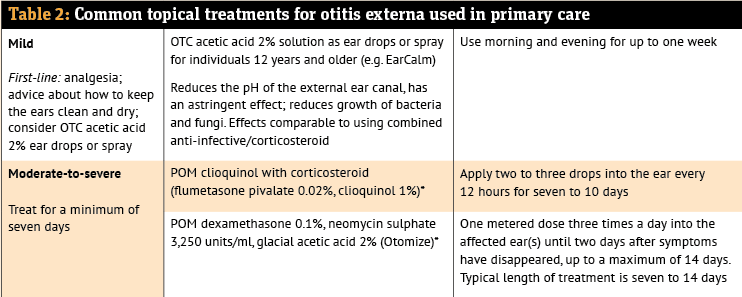Management
Otitis externa is usually caused by infection but it may also result from allergies, irritants or inflammatory conditions (all of which may also underlie bacterial infection).
Approximately 90 per cent of infected OE cases are bacterial. Pseudomonas infections account for two-thirds of instances and staphylococcal infections are the next most common. The remaining 10 per cent of infections are fungal – aspergillus is the most common form.
For mild cases, acetic acid drops are often sufficient to help clear the infection. These can be provided by the pharmacy OTC.
For more severe or persistent cases, topical treatments containing an antibiotic alone or in combination with a corticosteroid are usually effective (see Table 2, below).
Pain should be managed with paracetamol or ibuprofen. Oral antibacterials are rarely indicated.
A systemic antibacterial may be considered if the infection is spreading outside the ear canal, the patient is systemically unwell, or in a high risk group (e.g. people with diabetes, patients who are immunocompromised, those with severe infection or who are at high risk of severe infection such as pseudomonas).
Particularly severe cases – mainly where the ear canal is swollen or occluded – may be treated by clearing the ear out using microsuction, followed by packing the ear with gauze soaked in antiseptic. This is usually done by ENT specialists.
These cases can be very painful and there may be systemic features, such as lymphadenopathy and pyrexia. Oral or even parenteral antibiotics are generally required.
A boil (furuncle) in the ear canal, usually caused by staphylococcal infection, can cause intense pain because of pressure in the confined skin and cartilage.
There may be associated cellulitis. If this is the case, systemic antibiotics are indicated, and flucloxacillin would be the treatment of choice (in those not allergic to penicillins).
Effective pain relief can be achieved using regular paracetamol or ibuprofen. These can be combined with codeine when the pain is more severe, although the evidence of benefit is not definitive. Applying heat by holding a hot flannel against the ear can help to relieve the pain.
*Denotes use in the UK community pharmacy NHS & private PGDs. For a more complete list, see BNF or NICE CKS.
Advice on using ear drops and sprays in OE
Many people may not have previously used ear drops and may not know how to do so correctly. Providing advice about how to use ear drops is therefore important. Patients should be told to:
- Wash hands before beginning
- Lie down, or tilt the head a little, so that the affected ear is facing upwards
- Gently pull earlobe to straighten the ear canal
- Release four to five drops into the ear to fill the ear canal. Try not to touch the inside of the ear with the dropper as this is done. If the drops are for a child, only insert as many drops as are needed to fill the ear canal
- Massage the front of the ear to encourage the drops to flow down the ear canal
- Keep the ear facing upwards for five to 10 minutes to retain the solution in the ear
- Repeat the process in the other ear if asked to use the drops in both ears.
(Source: NHS Northern Alliance patient information: northerncarealliance.nhs.uk/patient-information/patient-leaflets/ent-how-use-ear-drops)
Ear sprays should be used when sitting upright with the earlobe gently pulled upwards and backwards to open the ear canal.
Advice on giving ear drops or spray to a child is available at gosh.nhs.uk/conditions-and-treatments/medicines-information/how-give-your-child-ear-drops-or-spray.

